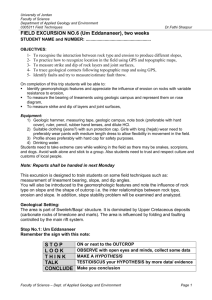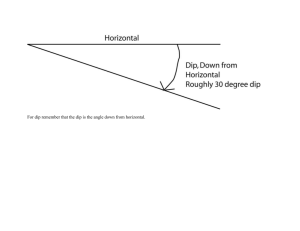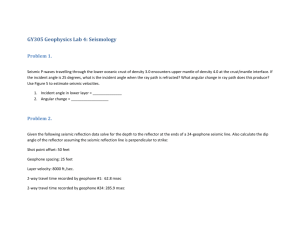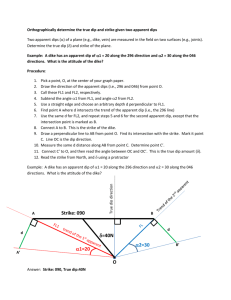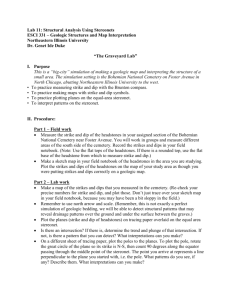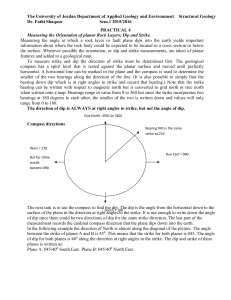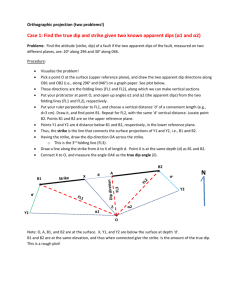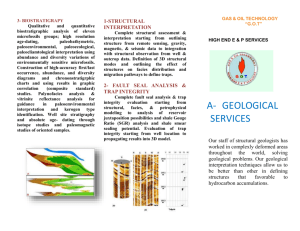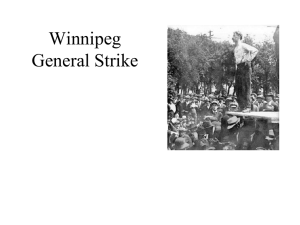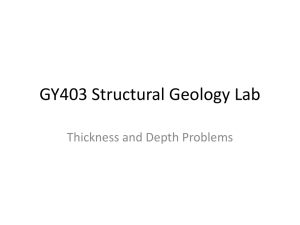Structural Geology & Geophysics: Orientation & Techniques
advertisement
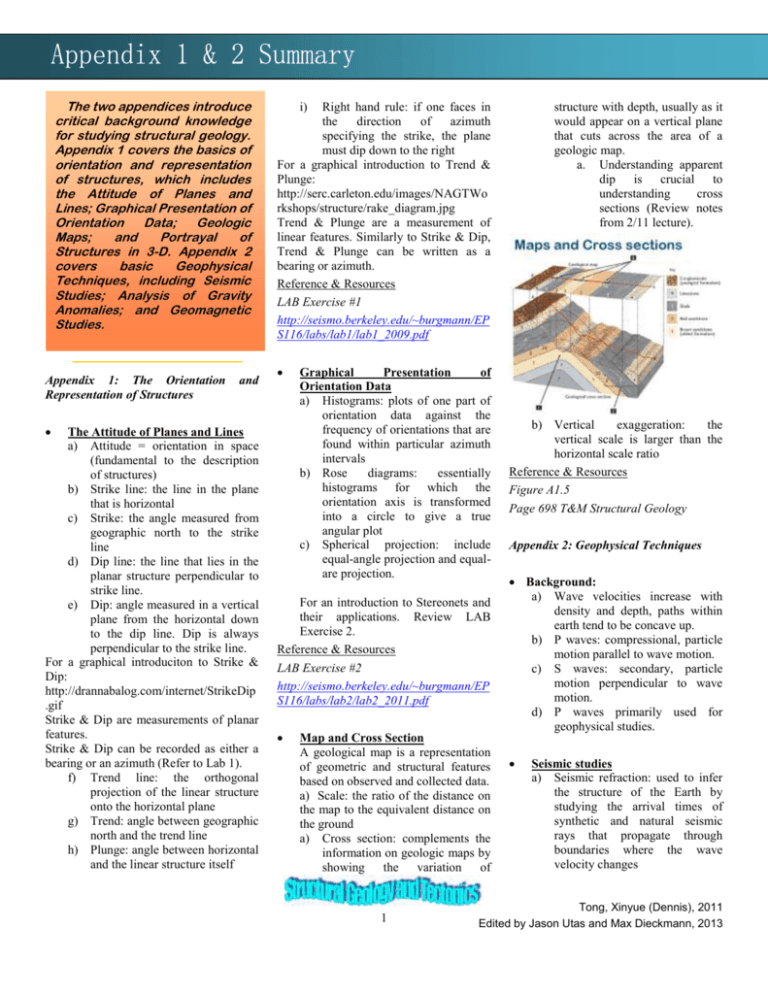
The two appendices introduce critical background knowledge for studying structural geology. Appendix 1 covers the basics of orientation and representation of structures, which includes the Attitude of Planes and Lines; Graphical Presentation of Orientation Data; Geologic Maps; and Portrayal of Structures in 3-D. Appendix 2 covers basic Geophysical Techniques, including Seismic Studies; Analysis of Gravity Anomalies; and Geomagnetic Studies. Appendix 1: The Orientation Representation of Structures and i) Right hand rule: if one faces in the direction of azimuth specifying the strike, the plane must dip down to the right For a graphical introduction to Trend & Plunge: http://serc.carleton.edu/images/NAGTWo rkshops/structure/rake_diagram.jpg Trend & Plunge are a measurement of linear features. Similarly to Strike & Dip, Trend & Plunge can be written as a bearing or azimuth. Reference & Resources LAB Exercise #1 http://seismo.berkeley.edu/~burgmann/EP S116/labs/lab1/lab1_2009.pdf The Attitude of Planes and Lines a) Attitude = orientation in space (fundamental to the description of structures) b) Strike line: the line in the plane that is horizontal c) Strike: the angle measured from geographic north to the strike line d) Dip line: the line that lies in the planar structure perpendicular to strike line. e) Dip: angle measured in a vertical plane from the horizontal down to the dip line. Dip is always perpendicular to the strike line. For a graphical introduciton to Strike & Dip: http://drannabalog.com/internet/StrikeDip .gif Strike & Dip are measurements of planar features. Strike & Dip can be recorded as either a bearing or an azimuth (Refer to Lab 1). f) Trend line: the orthogonal projection of the linear structure onto the horizontal plane g) Trend: angle between geographic north and the trend line h) Plunge: angle between horizontal and the linear structure itself Graphical Presentation of Orientation Data a) Histograms: plots of one part of orientation data against the frequency of orientations that are found within particular azimuth intervals b) Rose diagrams: essentially histograms for which the orientation axis is transformed into a circle to give a true angular plot c) Spherical projection: include equal-angle projection and equalare projection. For an introduction to Stereonets and their applications. Review LAB Exercise 2. Reference & Resources LAB Exercise #2 http://seismo.berkeley.edu/~burgmann/EP S116/labs/lab2/lab2_2011.pdf Map and Cross Section A geological map is a representation of geometric and structural features based on observed and collected data. a) Scale: the ratio of the distance on the map to the equivalent distance on the ground a) Cross section: complements the information on geologic maps by showing the variation of 1 structure with depth, usually as it would appear on a vertical plane that cuts across the area of a geologic map. a. Understanding apparent dip is crucial to understanding cross sections (Review notes from 2/11 lecture). b) Vertical exaggeration: the vertical scale is larger than the horizontal scale ratio Reference & Resources Figure A1.5 Page 698 T&M Structural Geology Appendix 2: Geophysical Techniques Background: a) Wave velocities increase with density and depth, paths within earth tend to be concave up. b) P waves: compressional, particle motion parallel to wave motion. c) S waves: secondary, particle motion perpendicular to wave motion. d) P waves primarily used for geophysical studies. Seismic studies a) Seismic refraction: used to infer the structure of the Earth by studying the arrival times of synthetic and natural seismic rays that propagate through boundaries where the wave velocity changes Tong, Xinyue (Dennis), 2011 Edited by Jason Utas and Max Dieckmann, 2013 b) Seismic reflection: the structure of the Earth is revealed by reflections of P waves off internal boundaries and heterogeneities. c) Record section: the resulting plot of seismic studies d) Stacking: method of enhancing the signal-to-noise ratio by adding together reflections that occur at different angles from the same subsurface point e) Migration: a technique that allows the true locations of reflectors to be determined. All reflections are plotted as though they are vertical reflections, eliminating artifacts and errors un raw record. f) First motion studies: First arrival of a P wave, characterized by compression or rarefaction, determined by the orientation of the fault and slip direction. Used to determine the orientation of and sense of slip on faults at depth. Reference & Resources Box A2-2 and Figure A2.2 Page 705 T&M Structural Geology Earthquake Geometry a) Gravity Anomaly: The difference between a measured value of the acceleration due to gravity at a given location and a reference value for the given location. b) Assumptions for reference values: (1) gravity measured at sea level and (2) all surrounding topography is level/lacks topographical variation. Corrections that must be applied to gravity measurements: a) Free-air = difference due to altitude above sea level b) Bouguer = corrects for local topography (differences in gravity readings due to nearby mountains ,valleys, etc.) Often referred to as “terrain correction.” Note: Gravity anomalies are unspecific and can often reflect a variety of underlying structures such as faults or intrusions. Reference & Resources Figure A2.4 Page 709 T&M Structural Geology Geomagnetic Studies Magnetic anomalies: measurements of the variation of the Earth’s magnetic field relative to some locally defined reference. Generally used to infer underlying rock types and structures that may be covered by other rocks, sediments, or structures. Reference & Resources Figure A2.3 Page 708 T&M Structural Geology Analysis of Gravity Anomalies Paleomagnetism: found by measuring the orientation of magnetic fields preserved in rocks. Can tell us (1) about the strength of the field in the past, (2) the direction of the magnetic field and times of pole reversals, and (3) the latitude at which a given sample was magnetized. Reference & Resources Figure A2.5 Page 712 T&M Structural Geology 2 Tong, Xinyue (Dennis), 2011 Edited by Jason Utas and Max Dieckmann, 2013
